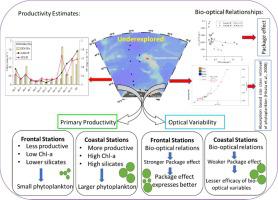Progress in Oceanography ( IF 3.8 ) Pub Date : 2021-04-15 , DOI: 10.1016/j.pocean.2021.102573 Anvita U. Kerkar , S.C. Tripathy , David J. Hughes , P. Sabu , S.R. Pandi , A. Sarkar , M. Tiwari

|
Knowledge of Southern Ocean carbon cycling is limited by a paucity of phytoplankton primary productivity (PP) and spectral absorption data in this globally-important region. We measured 13C-based PP in the Indian sector of Southern Ocean (ISSO) during austral summer 2017, examining its link with spectral absorption coefficients and phytoplankton size structure derived from an absorption-based global model. Phytoplankton productivity was assessed at both coastal (60°S-69°S) and frontal stations (40°S-60°S), characterized by silicate- replete and -deplete water masses, respectively (indicated by measured nutrient ratios) to capture a range of phytoplankton growth conditions. Bio-optical relationships were used as indicators of phytoplankton community size structure and to assess the extent of cellular pigment packaging - a phenomenon reported previously for phytoplankton in this region. Blue-Red (B/R) ratios of phytoplankton absorption (aph) spectra indicated that microphytoplankton (more prone to “package effects”) were the dominant size class at most sites sampled. Overall, PP was better explained by aph (R2 = 0.85) than total chlorophyll-a (R2 = 0.64) in surface waters. The a*ph (675)-chlorophyll-a relationship explained package effects more effectively in frontal regions (R2 = 0.63) than stations further south (R2 = 0.30). The global absorption-based model captured smaller (pico, nano) phytoplankton size classes but failed to identify larger microphytoplankton, underscoring the need for region-specific algorithm modifications. Our findings improve existing understanding of spatio-temporal trends in PP and bio-optical variability within the Indian Sector of the Southern Ocean (ISSO) – knowledge that is essential to improve capacity to retrieve PP from satellite-based models in this region.
中文翻译:

极地海洋生态系统中浮游植物生产力和生物光学变异性的表征
在这个全球重要的地区,由于缺乏浮游植物的初级生产力(PP)和光谱吸收数据,对南大洋碳循环的认识受到限制。我们测量了132017年夏季,印度南部海洋(ISSO)中基于C的PP进行了研究,研究了其与光谱吸收系数和浮游植物大小结构的联系,该光谱吸收系数和浮游植物的大小结构源自基于吸收的全球模型。在沿海地区(60°S-69°S)和额叶站(40°S-60°S)对浮游植物的生产力进行了评估,其特征分别是富含硅酸盐的水质和缺乏硅酸盐的水质(通过测得的养分比表示)以捕获一系列浮游植物的生长条件。生物光学关系被用作浮游植物群落大小结构的指标,并用于评估细胞色素包装的程度-以前曾报道过该地区浮游植物的现象。浮游植物吸收量(ph值)的蓝红色(B / R)比)光谱表明,在大多数采样点,浮游植物(更容易产生“包裹效应”)是主要的大小类别。总体而言, 地表水中的ph值(R 2 = 0.85)比总叶绿素a(R 2 = 0.64)更好地解释了PP 。a * ph(675)-叶绿素-a的关系说明,在额叶区域(R 2 = 0.63)比在更南端的站(R 2 = 0.30)。基于全球吸收的模型捕获了较小的(微微,纳米)浮游植物大小类别,但未能识别出较大的浮游植物,这突出说明了需要对特定于区域的算法进行修改。我们的发现增强了对南洋印度洋(ISSO)内PP时空趋势和生物光学变异性的现有理解-这些知识对于提高从该地区基于卫星的模型中检索PP的能力至关重要。










































 京公网安备 11010802027423号
京公网安备 11010802027423号